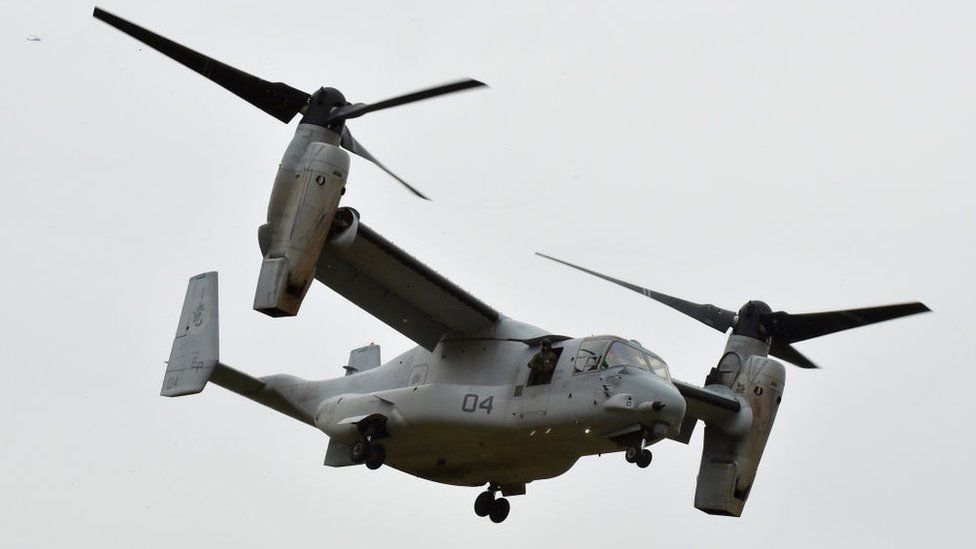ARTICLE AD BOX
 Image source, Getty Images
Image source, Getty Images
V-22 Ospreys are operated by the US Marines, Navy and Air Force and by the Japan Self-Defence Forces
By Bernd Debusmann Jr
BBC News, Washington
A deadly crash off the coast of Japan has once again sparked concerns about the safety of the US military's V-22 Osprey aircraft.
The incident marks the fourth time in two years that US-operated Ospreys were involved in fatal accidents.
Japan, the only other nation to operate Ospreys, has grounded its fleet and asked the US to do the same until the cause of the crash is determined.
The US has so far refused, and in the past insisted the aircraft is safe.
While the Pentagon has yet to determine what caused the crash, a string of incidents previously led the military to express concerns about clutch issues and difficulties maintaining the complex aircraft.
First introduced in 2007, the V-22 Osprey is a tiltrotor aircraft, which means it functions both as a helicopter and a turboprop aircraft. It takes off and lands similar to a helicopter, but rotates its propellers forward and flies like an airplane in flight, allowing it to travel faster and over longer distances.
Hundreds of Ospreys are operated by the US Marine Corps, US Navy and by the US Air Force's Special Operations Command, which primarily uses the aircraft, in addition to the Japanese military.
The aircraft has seen extensive active service during US military operations, including combat missions in Iraq, Afghanistan and Libya.
But they have also been involved in a string of mishaps - including some that led to the deaths of service members - and prompted concerns about the aircraft's safety and airworthiness.
In Japan, Chief Cabinet Secretary Hirokazu Matsuno said that Japan had officially requested that US Ospreys operating in Japan be grounded, adding that the government was "concerned that flights are being carried out without sufficient explanation about safety confirmation, despite repeated requests from Japan".
Earlier, in 2019, then-Colonel Dave White, who oversaw the Air Force's Osprey programme, said that "CV-22 readiness keeps me up at night.
"It's not what it needs to be. It's a tough platform to maintain," he added.
Earlier this year, three US Marines were killed and 20 others injured when an Osprey crashed during a training exercise in Australia.
Image source, Getty Images
Image caption,US military Ospreys saw extensive service in Afghanistan before the US withdrew in August 2021
That incident came just over a year after another Osprey crashed in the California desert, killing five. Another crash - which was found to be the result of pilot error - killed four Marines in Norway in March the same year.
A Marine Corps investigation later determined that the California crash was the result of clutch problems - an issue that had also been reported by the Air Force on several occasions and which prompted the service to temporarily ground its fleet.
"I wouldn't right now apply a sweeping broad stroke across every incident linking them together," Pentagon spokeswoman Sabrina Singh said when asked about the issue last year.
Despite the high-profile accidents, statistics show that the aircraft is not more dangerous to operate than others in US military service.
In a 2022 statement to the Marine Corps Times, a Marine aviation spokesman said that the service's Ospreys had a lower mishap rate per 100,000 flight hours than three of its jet fighters - the Harrier, the F/A18 Super Hornet and the F-35 - as well as its primary helicopter, the CH-53E Super Stallion.
When asked by the BBC about safety precautions in the wake of the most recent crash in Japan, the Pentagon said that the unit that flew the plane is not flying and that "all V-22 Ospreys in Japan operate only after undergoing thorough maintenance and safety checks".
"The United States is taking all appropriate safety measures, as we do for every flight and every operation," Ms Singh said in a statement.
Last week, the Pentagon said that investigators are still working to determine what exactly caused the crash in Japan.
"Should that investigation yield results that require the department to change anything about the Osprey or to take additional steps, we will certainly do that," Ms Singh said.

 1 year ago
34
1 year ago
34








 English (US) ·
English (US) ·